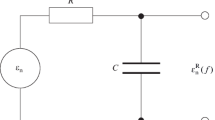Abstract
Provided that the one-dimensional wave equation applies, strain measurement at two sections of a linearly elastic cylindrical rod makes it possible to determine a number of important quantities at an arbitrary section of the rod; for example, strain, particle velocity and power transmission. The equations needed are derived, and the design of an analogue real-time analyzer is presented. The influence of some principal sources of error is analyzed and it is shown that it should be possible to perform accurate evaluation (errors less than a few percent) during a time interval which is not very long compared to the travelling time for a wave between the two gage positions. Comparisons are made between direct measurement and digital evaluation of strain, and between digital and analogue evaluation of particle velocity and power transmission. The discrepancies are typically less than ten percent during a time interval of 20 travelling times between gages. Although these results do not represent what is achievable, the accuracy is sufficient in several applications and demonstrates the feasibility of the method used.
Similar content being viewed by others
Abbreviations
- A :
-
cross-sectional area (m2)
- c :
-
bar velocity (m/s)
- E :
-
Young's modulus (N/m2)
- F 0(t):
-
compressive force atx=0 (N)
- f(t) :
-
arbitrary function (m)
- g :
-
gage factor
- h(t) :
-
arbitrary function (m)
- P 0 (t),P 1 (t) :
-
power transmissions atx=0 andx=x 1, respectively (W)
- R 0 :
-
resistance (ohm)
- T,T 1,T 2 :
-
time constants (s)
- T R :
-
rise time (s)
- t :
-
time (s)
- U A :
-
calibration voltage (V)
- U P0 ,U P1 :
-
voltages representingP 0 andP1. respectively
- U r :
-
calibration constant (V)
- U v0 ,U v1 :
-
voltages representingv 0 andv 1, respectively (V)
- U ε0,U ε1,U ε2 :
-
voltages representing ε0, ε1, ε2, ε A and ε B
- U εA,U εB :
-
respectively (V)
- U 0 :
-
factor of proportionality (V)
- u(x, t) :
-
displacement (m)
- v 0 (t), v 1 (t) :
-
particle velocities atx=0 andx=x 1, respectively (m/s)
- x, x 1 ,x 2 :
-
position coordinates (m)
- Z 0 :
-
characteristic impedance (ohm)
- ΔC :
-
calibration error for strain measurement
- ΔG :
-
error in open-loop gain
- ΔT :
-
error in time distance between gages (s)
- ε0 (t), ε1 (t), ε2 (t), ε A (t), ε B (t) :
-
strains atx=0,x=x 1, ‘A’, and ‘B’, respectively
- σ0 (t) :
-
stress atx=0 (N/m2)
References
Lundberg, B., “Energy Transfer in Percussive Rock Destruction I, II and III,”Int. J. Rock Mech. Min. Sci. & Geomech, Abstr., (10),381–435 (Sept.1973).
Fischer, H. C., “On Longitudinal Impact—IV Pile Driving,”Appl. Sci. Res., (9),93–138 (1960).
Holister, G. S., Experimental Stress Analysis, Cambridge University Press, Cambridge (1967).
Kolsky, H., Stress Waves in Solids, Dover Publications, Inc., New York, 41–65 and 116–122 (1963).
Huerre, J. P., “Lignes à retard électromagnétiques,” Techniques de l'Ingénieur, Paris, (618), 1–6.
Author information
Authors and Affiliations
Rights and permissions
About this article
Cite this article
Lundberg, B., Henchoz, A. Analysis of elastic waves from two-point strain measurement. Experimental Mechanics 17, 213–218 (1977). https://doi.org/10.1007/BF02324491
Issue Date:
DOI: https://doi.org/10.1007/BF02324491




